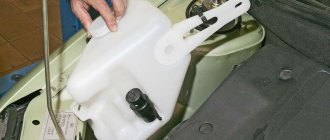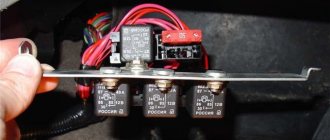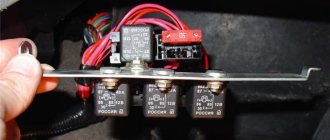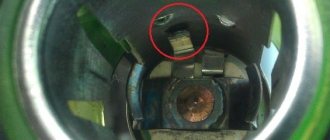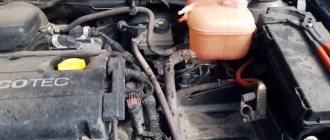Liquid for front and rear window washers, as well as headlights on cars where this option is provided, has long been used in a non-freezing all-season version. This composition is optimal in its cleaning properties, including thanks to the component that prevents the formation of ice. But the desire to save money forces many car owners to use ordinary water with the addition of detergents in the summer.
How to defrost the washer reservoir
- 40 0 97k
- 2 0 6k
The most effective way to warm up a reservoir with washer fluid frozen inside is to place it in a place with above-zero temperatures: a warm garage, a car wash, a shopping center parking lot.
Or you can remove it and take it home until the ice completely melts. However, they all require quite a lot of time. No less effective will be the following: pouring winter washer concentrate (“anti-freeze”), alcohol-containing liquids or boiling water. But such options have their own nuances and application features. In addition to the basic defrosting methods, there are other options for warming up the washer reservoir, which, depending on your capabilities, can also be successfully used.
There are many options for defrosting or warming up the washer reservoir in your car in winter. They all have their pros and cons, which we have compiled in the table below. For a detailed description of each method, read the article.
There are several methods to drain water from the windshield washer reservoir:
- turning on the wipers with washer and running out all the liquid;
- suction with a bulb, syringe, spray bottle with a hose of sufficient length;
- by disconnecting the washer supply hose from the line and draining the liquid into a bottle (it is better to remove the wiper fuse so that they do not waste time on the glass).
Why does the fluid in the washer reservoir freeze?
With the first frost, it is not enough to simply drain the water from the tank; you must thoroughly rinse the entire system. If you immediately fill the “anti-freeze”, it will not help to instantly melt the ice plugs that have formed. The pump motor, supply lines and nozzles, spraying liquid onto the glass, may freeze.
The same effect will occur if the non-freezing liquid does not meet the declared characteristics, when the frost is too severe or the amount of water in the composition exceeds the minimum allowable percentage for a given temperature.
Most often, drivers simply forget that there is water in the washer. The massive use of antifreeze in engines has led to the fact that the zero temperature threshold has ceased to play a role in the operation of cars. The error is detected only when the glass, translucent from dirt, needs to be cleaned.
We heat the tank itself
If the tank is filled with liquid up to the neck, it is recommended to work on the container.
Using a hair dryer
This option is suitable if the car is located near a power source and you have a hair dryer itself. In this case, direct a stream of warm air to the tank.
Do not bring the hair dryer too close and make sure that the stream is not hot. In both cases, you can deform the plastic container. As it thaws, pump out the water using a bulb and tube.
A household hair dryer will not cope with the task
Warming up the engine
When answering the question of how to thaw water in the washer reservoir in winter, experienced drivers most often recommend this method.
You don't need alcohol, a hair dryer or a portable socket. As a bonus, the ice will thaw not only in the container, but throughout the entire pipeline. In this case, everything happens due to the heat generated by the running motor.
It is best to warm up the engine indoors, but with the doors open
First, you need to start the engine itself and warm it up to standard operating temperature. The hot air circulating in the engine compartment will begin to affect the ice crystals in the tank and hoses.
You can check whether the process has started after 10 minutes. If you find that the ice crystals have begun to melt, continue to keep the motor running.
If the whole process is carried out outside in the cold, you will need several hours to get the desired result. This is why experienced drivers recommend driving into a warm room, such as a garage or underground parking. Ideally, you can cover the hood with a car blanket. In this case, in literally half an hour you can completely defrost not only the tank, but also the entire system, including the injectors.
The water must be drained and the main line must be fed with a high-quality composition
Motorists often recommend combining several methods, for example, starting the engine and simultaneously pouring hot water, alcohol or anti-freeze into the tank. This will speed up the process significantly.
Method 5
In the absence of a hair dryer, there is a less radical way to warm the tank. True, it will require a large-section gardening hose.
The hose can be pulled over the exhaust pipe and pulled to the engine compartment. When the engine warms up, warm air comes out of the exhaust pipe. When the hose is compressed, the pressure increases, and a warm stream of exhaust gases can warm the pipes and the frozen tank itself. This procedure must be carried out outdoors, since it is impossible to keep a car with the engine running in a garage due to the risk of exhaust gas poisoning.
How to defrost water in the washer reservoir
In general, the procedure for solving the problem that has arisen is elementary:
- defrost ice; drain the thawed water; fill with anti-freeze.
But the time costs and nature of the manipulations will depend on:
- volume of frozen water in the tank; possible freezing of the entire washer system; the performance of the motor supplying the washer.
1. Therefore, if possible, you need to visually assess or remember how full the washer reservoir is with water. In case:
- there is space in the container free of ice, and the electric motor is functioning,
How exactly to do this, read in the section below.
2. In a situation with a non-working motor, you will have to contact an auto electrician. Determining the state of affairs is very simple:
- The running engine will make noise when trying to apply washer to the windshield.
How to defrost ice
You can defrost water:
- pour heated water, antifreeze or just vodka into the tank; When you go to the car wash, wash your car with hot water; by placing the car in a warm garage or service station.
Each of the first two options has its pros and cons.
Defrosting (thawing) when the system is not completely frozen
The situation is most convenient for the driver, especially if a thaw is predicted.
1. Heat the liquid to be filled to 70 degrees and gradually add it to the washer fluid reservoir.
If the option is positive, the ice will gradually thaw, and water diluted with alcohol or anti-freeze must be released through the spray nozzles on the hood.
2. Carry out the process until the tank is completely empty, into which you then pour anti-freeze.
3. Blow the system filled with “winter” fluid through the washer supply nozzles several times.
How to defrost washer fluid in the reservoir
The washer fluid in the washer reservoir has frozen in the cold, and you need to hit the road. But how can you drive with dirty glass and not become involved in a traffic accident? A more logical question to ask is how to defrost the mechanism and clean the windshield? There are several tips for this case.
In practice, every motorist may encounter the problem of liquid freezing in the windshield washer reservoir. And this happens not only because of severe frosts, but also because of the quality of the liquid itself. Mixed washer can even be sold in supermarkets. As a rule, high-quality winter liquid can withstand even very low temperatures. However, there is another reason why the washer can turn into a piece of ice. This happens when, before the onset of winter, ordinary water remains in the tank, which can be very difficult to defrost. Now let’s look at effective ways to quickly solve the problem.
Warm room . This is the most effective and simplest method in practice. In order for the washer to melt, you need to put the vehicle in a heated garage or parking lot. However, the process itself may take several hours. In addition, the underground parking of the shopping center can be used for these purposes. In the latter case, you can spend your time usefully - go shopping or go to the cinema. Warm up the engine . As a rule, the washer reservoir is located close to the engine. Therefore, if you warm up the power plant well, you can automatically solve this problem. It is best to warm up the engine while the car is parked; driving with dirty glass is not recommended. In addition, while driving, heat will escape from under the hood, and the washer reservoir may freeze even more. Alcohol or concentrate . If the antifreeze has turned into a lump, it can be melted with alcohol. To do this, you can take the cheapest bottle of vodka from the store, add liquid to the tank and wait until the effect appears.
Take the tank to a warm room . If all other methods do not work, then you can remove the container with washer fluid and take it to a warm place. However, this method is not suitable for everyone, since not in all cars the tank can be removed so easily. To remove the container, you need to unscrew several bolts and remove the hose. Apply hair dryer . Using a regular hair dryer, you can easily warm up the tank. To do this, you need to direct a stream of air to the container and wait until the liquid melts again. This method is suitable for those who have access to electricity and an outlet. Washing . The most radical method of dealing with ice is to go to a car wash and ask specialists to melt the liquid with warm water.
Bottom line . If the water in the tank is frozen, there are several ways to help solve the problem. Some of them can be done on the spot.
We drown the ice with vodka or alcohol
In vodka, the alcohol content is at the level of 40%, which, if it gets on ice, will cause a reaction with the release of heat.
Advice! If you add pure alcohol (96%) to the tank, the melting process will occur much faster.
When it's too cold outside and there's too much frozen water, the reaction will be slow or not happen at all.
To enhance the effect, vodka is first brought to a boil and then poured into the tank. The procedure is carried out in several approaches so that the hot liquid does not harm the plastic, since a sharp temperature change can lead to deformation of the structure.
What if the tank is under the bumper?
Everything would be fine, but the layout of the engine compartment does not always allow easy access to the windshield washer system reservoir. This is on Vesta, Logan, Duster, the reservoir is in the free access zone. But what about the owners of Kia Rio, Hyundai Solaris and other foreign cars, under the hood of which you can only see a neck with a blue cap.
Our colleagues from the magazine “Behind the Wheel” urge you to discard the idea of labor-intensive dismantling of the tank. Instead, the well-known editors proposed a very interesting method:
- Heat a good anti-freeze solution or a concentrate diluted to the minimum temperature in a water bath.
- Pour the heated mixture into the frozen container.
- Mix the liquid in the tank using a tire compressor for 2-3 minutes.
- Drain the cooled washer fluid from the reservoir into a container using the old-fashioned method of draining gasoline from the fuel tank. Insert the hose into the tank, create a vacuum in it and direct the stream into a container located obviously below the frozen tank.
“Zarulevtsy” insist on repeating the described procedures until the windshield washer system is completely defrosted.
At the same time, it would be nice for the engine to be thoroughly warmed up and running: extraneous heat will speed up the defrosting of the windshield washer. The proposed method is good. Including because it is adapted to non-standard conditions. So, far from civilization, a canister of anti-freeze can be heated directly on the engine. Yes, it will take almost 20-30 minutes to boil a five-liter bottle, but still... Disadvantages - the tank must be half empty, the temperature difference is insignificant so that the tank does not crack.
Forced defrost
We will need a hose, a bulb, antifreeze concentrate, a pump or compressor, and a bottle for collecting liquid. Where can I get this and how much does it cost?
We get a medium-sized pear at the pharmacy, it cost us 185 tenge. You can also purchase a system there, but this is plan Z. The system tubes are thin and soft. It’s not easy to push them into the tank, and it will take a long time to drain. If it happens at all. We haven't tested it, although we bought the system. Cost 125 tenge.
Hose. Good, moderately tough - half the success. You can buy one at an auto parts store (for rosavtoprom and trucks). The price of a meter fuel hose for a Niva is 940 tenge, a steam exhaust pipe from a VAZ-2108 is 510 tenge, a plastic one is 880 tenge per meter.
Before going to the store, it is important to determine the length of the hose. In order for the liquid to flow from the tank according to the law of communicating vessels, it is important that the second end of the hose hangs below the tank. A meter is most likely not enough.
A compressor with a long hose will be needed to mix the contents. Fortunately, we had one.
The antifreeze concentrate needs to be heated, but carefully. Firstly, the lower the temperature the washer keeps, the more alcohol it contains, which means the better it burns. In other words, you definitely shouldn’t heat it over an open fire (don’t forget about the steam), that is, do it in a water bath. Secondly, anti-freeze vapors do not contain anything beneficial to health.
Have you collected everything you need? Great, let's start defrosting. Pour the heated liquid into the tank. We lower the pump or compressor hose there.
It gurgles, it stirs, it needs to be drained. For the reasons outlined above, suctioning a hose with your mouth is a bad idea. This is also inconvenient, because you need to “lie down” below the bumper. This is where the pear comes in handy. We create a vacuum, lower the outer end of the hose below the tank (substitute the container), the liquid will flow according to the law of communicating vessels. We repeat the procedure until the enemy is completely dissolved.
When everything has been drained, we fill the tank with high-quality anti-freeze and press the lever under the steering wheel until we are completely sure that it is this that is pouring onto the glass.
To melt the ice in the nozzles and lines, the easiest way is to pour hot water over them. Alternatively, glass and lock defrosting liquid will help revive the injectors.
This cannot be done if the liquid is frozen.
Warming up windshield washer fluid is a labor-intensive procedure that requires great care and compliance with safety precautions. When heating a frozen antifreeze, you must not:
- create strong temperature changes so as not to damage the components of the glass washing system (the use of boiling water, open fire, and strong heat is excluded);
- if the windshield washer reservoir is located above the wing of the car, prolonged warming up of the engine will not help - you will only burn the fuel: combined heating methods should be used here;
- All stages of heating the anti-freeze should be performed slowly and with pauses so as not to damage the frozen pump (impeller and washer pump motor).
Why does the washer reservoir freeze?
Naturally, the main reason for freezing of the fluid in the washer reservoir is low air temperature. In some cases, even having a warm garage does not help car enthusiasts.
Since when leaving it in the morning, no one is protected from the fact that, just by parking for a couple of hours in the cold, a surprise will await you with the freezing of the washer reservoir.
To ensure that all components of the car work in unison, some drivers prepare very carefully for the winter season. They not only change tires, oil, spark plugs, but also test the operation of the battery and air conditioning system. They also think about the proper operation of the windshield wiper unit.
Nice way
The easiest and most pleasant way to defrost your antifreeze is to go to a shopping and entertainment center equipped with a warm parking lot. While the car is warming up in the parking lot (most likely, a paid one), you go shopping, watch a movie, eat and have a good time. Didn't thaw out in half a day? We sympathize, but nothing can be done. We'll have to have some more fun.
The chances of success increase if there is little fluid in the tank, if it is relatively warm outside, if you leave the car in the warmest place in the parking lot or for a long time.
True, it may turn out that “Khan Shatyr” or “Dostyk Plaza” is far from you. Look for a warm box or negotiate at a car wash. The latter, if they work only during the day, may well be allowed in at night for a certain fee.
In both cases, be sure to then get rid of the defrosted liquid by running the windshield washer for long periods of time. By the way, it could freeze not only in the tank, but, for example, in the pipes and injectors.
How to melt ice in a windshield washer reservoir - a few simple ways
Windshield washer reservoir neck
Next, we will consider several effective methods that can help get rid of ice in the washer reservoir if it is not possible to put the car in a warm place or dismantle it. Everything that can help remove ice from the tank:
- hot water;
- hair dryer;
- non-freezing liquid;
- alcohol or alcohol-containing liquids;
- engine.
Each of the methods is good in its own way, so let’s look at each of them in more detail. So, there is a car in which ice has formed in the washer system reservoir due to the fact that they forgot to replace the water with a special non-freezing liquid in time.
The first thing you need to do is estimate how much ice there is. From this the method is chosen. If the tank is “full to capacity”, then it will not be possible to use any liquid for defrosting simply because there will be nowhere to fill it.
What can't you do?
Do not try to warm the windshield washer system hoses with an open flame, such as a burning newspaper. Such a decision, instead of returning the jets from the injectors, can turn into a spontaneous protest against the frost with the burning of a car
You should also use industrial hair dryers with caution - the air temperature they produce can melt the plastic components of the car or cause a gasoline fire
The situation is similar with “blower” heaters; if they are left turned on unattended, there is a considerable risk of damage to the equipment or fire of the car. You can use them to defrost the system, but only under your own supervision. Flows of warm air must be directed to the extreme points - nozzles or a fluid tank, if it is not “concreted” with ice, so that the water, which expands from the heat, has an outlet and does not lead to rupture of the hoses. Electric fireplaces, oil radiators and other similar devices are not suitable for this purpose.
It is clear that you should not force the pump motor that supplies water to the nozzles - this is not a bar ice maker. In the best case, the fuse will blow, in the worst case, the pump motor itself will burn out, and this is an extra expense.
Also classified as dubious is advice such as pouring alcohol or vodka into the system - this is unlikely to defrost the system, but the smell of alcohol may interest police officers. They have a well-developed sense of smell for such things. Hot, almost boiling water from a kettle for defrosting is not a good idea: you can damage the paint, rubber seals, or even crack the glass. Just warm water can help defrost the injectors, however, as it flows through different channels inside the car, it will linger and form new ice jams in other cavities.
